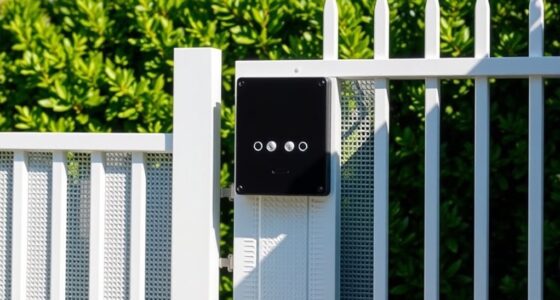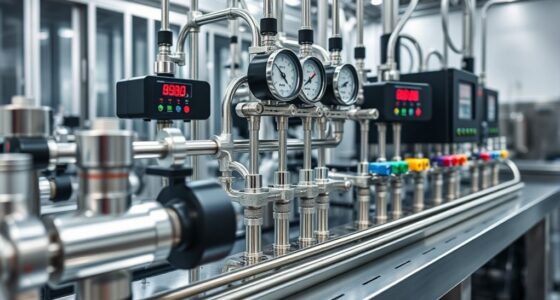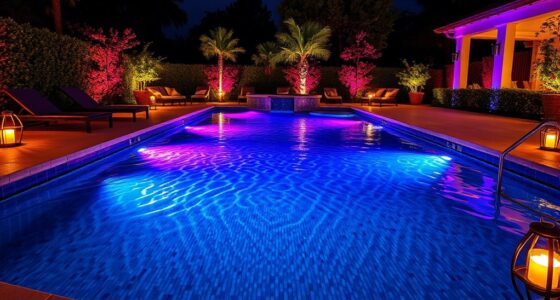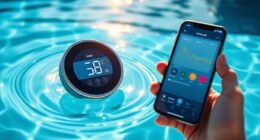Variable-speed pumps offer better energy efficiency and precise control compared to dual-speed and single-speed models. They automatically adjust motor speed to match your pool’s needs, saving you money on electricity and reducing wear and tear. Dual-speed pumps can switch between two fixed speeds but lack the fine-tuned control of variable-speed options. Single-speed pumps run constantly at one setting, wasting energy during low demand. Keep exploring to discover which pump best fits your pool and saves you more long-term.
Key Takeaways
- Variable-speed pumps offer adjustable flow rates, optimizing energy efficiency for different pool demands compared to dual- and single-speed pumps.
- Dual-speed pumps operate at two fixed speeds, providing some energy savings over single-speed but less flexibility than variable-speed models.
- Single-speed pumps run continuously at one fixed speed, often leading to higher energy consumption and less control over pool operation.
- Variable-speed pumps typically have higher upfront costs but deliver greater long-term savings through reduced energy and maintenance expenses.
- Dual-speed pumps provide a middle ground with limited speed options, suitable for moderate energy savings but less versatile than variable-speed pumps.
Understanding the Differences in Performance and Efficiency

Understanding the differences in performance and efficiency between variable-speed pumps and traditional fixed-speed pumps is crucial for making informed decisions. Variable-speed pumps adjust their motor speed based on demand, providing precise control over flow rates and pressure. This flexibility allows them to operate more efficiently, especially during low-demand periods, reducing energy consumption. Fixed-speed pumps run at a constant speed, often leading to unnecessary energy use when full capacity isn’t needed. As demand fluctuates, fixed-speed pumps either run inefficiently or require additional equipment like control valves. Variable-speed pumps optimize performance by matching output to actual needs, which improves overall system stability and minimizes waste. Recognizing these differences helps you select a pump that delivers better performance and long-term efficiency. Understanding energy savings associated with variable-speed pumps can further inform your investment in more sustainable systems.
Cost Implications and Long-Term Savings
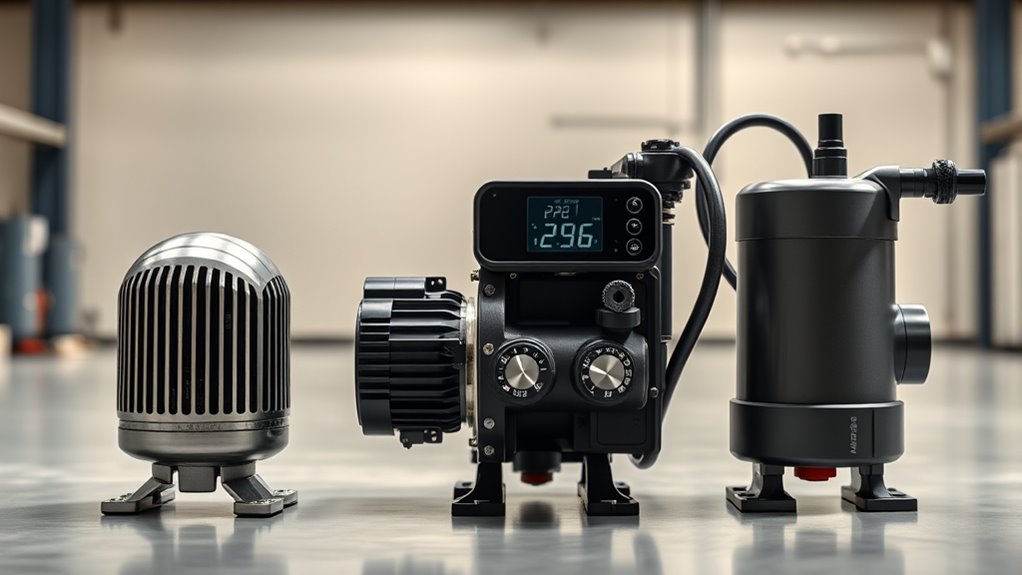
While variable-speed pumps often have higher upfront costs than fixed-speed models, they deliver significant long-term savings through reduced energy consumption and lower operating expenses. By adjusting speeds to match your pool’s needs, these pumps use less electricity, leading to noticeable savings on your energy bills over time. Additionally, because they operate more efficiently and generate less wear and tear, maintenance costs tend to decrease. Incorporating Kia Tuning modifications can further optimize system performance, extending the lifespan of your equipment. Furthermore, improved energy efficiency helps decrease your environmental impact and supports sustainable practices. Modern pump control systems and smart technology integrations can maximize efficiency and ease of operation, making these pumps even more advantageous. Although the initial investment is higher, the savings accumulate quickly, especially if you run your pump frequently. Over the pump’s lifespan, you’ll likely recover your upfront costs and enjoy ongoing financial benefits. Additionally, selecting a pump with advanced smart technology can provide real-time monitoring and control, further enhancing energy savings. An increased focus on system optimization ensures that your pump performs at its best, saving you money and reducing your ecological footprint. This efficiency not only saves you money but also reduces your pool’s environmental impact, making variable-speed pumps a smart long-term choice.
Suitability for Different Pool Sizes and Usage Needs

Variable-speed pumps adapt well to pools of various sizes and usage patterns, making them a versatile choice regardless of your specific setup. If you have a small pool with light usage, you can run the pump at lower speeds, saving energy while maintaining water clarity. For larger pools or heavy usage, you can increase the pump speed to ensure proper filtration and circulation. This flexibility allows you to tailor your pump’s performance to your needs, avoiding unnecessary energy consumption or underperformance. Additionally, energy-efficient features in modern variable-speed pumps help reduce operational costs over time. These features often include smart controls that optimize operation based on real-time conditions, further enhancing efficiency. The technological advancements in automation and control systems make it easier to customize your pool’s filtration schedule and performance. Moreover, incorporating renewable energy sources, such as solar power, can further decrease the environmental impact of running your pool equipment. The integration of advanced motor technology also contributes to quieter operation and increased durability, benefiting long-term use. Whether you swim daily or just seasonally, a variable-speed pump offers the adaptability to handle different demands efficiently. This makes it an ideal option for pool owners seeking a customizable solution that scales with their pool size and usage habits.
Frequently Asked Questions
How Do Installation Requirements Differ Among Pump Types?
When choosing a pump, installation requirements vary based on the type. You’ll find that single-speed pumps are straightforward and need minimal setup, often fitting existing systems easily. Dual-speed pumps require some wiring modifications for switching speeds. Variable-speed pumps need advanced controllers and proper electrical connections, making their installation more complex. You should follow manufacturer instructions carefully for each type to guarantee proper setup, efficiency, and safety.
Are Variable-Speed Pumps Quieter Than Dual- or Single-Speed Models?
Imagine a whispering breeze compared to a sudden gust—that’s how a variable-speed pump often operates. They’re generally quieter than dual- or single-speed models because they adjust their speed gradually, reducing noise. Data shows variable-speed pumps run smoothly at lower speeds, minimizing noise pollution. So, if quiet operation matters, a variable-speed pump acts like a gentle whisper, offering a peaceful environment unlike the more abrupt sounds of other types.
What Maintenance Is Needed for Each Pump Type?
You need to perform regular maintenance on all pump types to keep them running smoothly. For single-speed pumps, check and clean the filter and replace the seal if needed. Dual-speed and variable-speed pumps require software updates, motor inspections, and occasional lubrication of moving parts. Always keep an eye on vibrations and noise levels, and schedule professional inspections annually to prevent costly breakdowns and guarantee peak performance.
Can These Pumps Be Used With Smart Home Systems?
You can definitely integrate these pumps with smart home systems. Many modern pumps, especially variable-speed models, feature smart-compatible controls or can connect via Wi-Fi or Z-Wave networks. This allows you to monitor performance, adjust settings remotely, and automate operations through your smart home hub or app. Make certain your pump has the necessary connectivity features and compatible software, and you’ll enjoy more convenient and efficient control over your system.
How Do Energy Savings Vary With Pool Usage Patterns?
When considering energy savings, your pool’s usage patterns play a big role. If you swim often or run your pump frequently, you’ll see more savings with a variable-speed pump, which adjusts its power to match demand. Less frequent use means smaller savings, but a variable-speed pump still costs less to operate over time. Dual-speed and single-speed pumps offer less flexibility, so they save less energy overall.
Conclusion
Choosing the right pump is like picking the perfect key for a lock—you want it to fit just right. Variable-speed, dual-speed, and single-speed pumps each have their strengths, but understanding your pool’s size and usage helps you make the best pick. Investing wisely now can save you money and energy down the road, making your pool run smoothly like a well-oiled machine. Make the right choice today for a more effortless and efficient swimming experience tomorrow.


